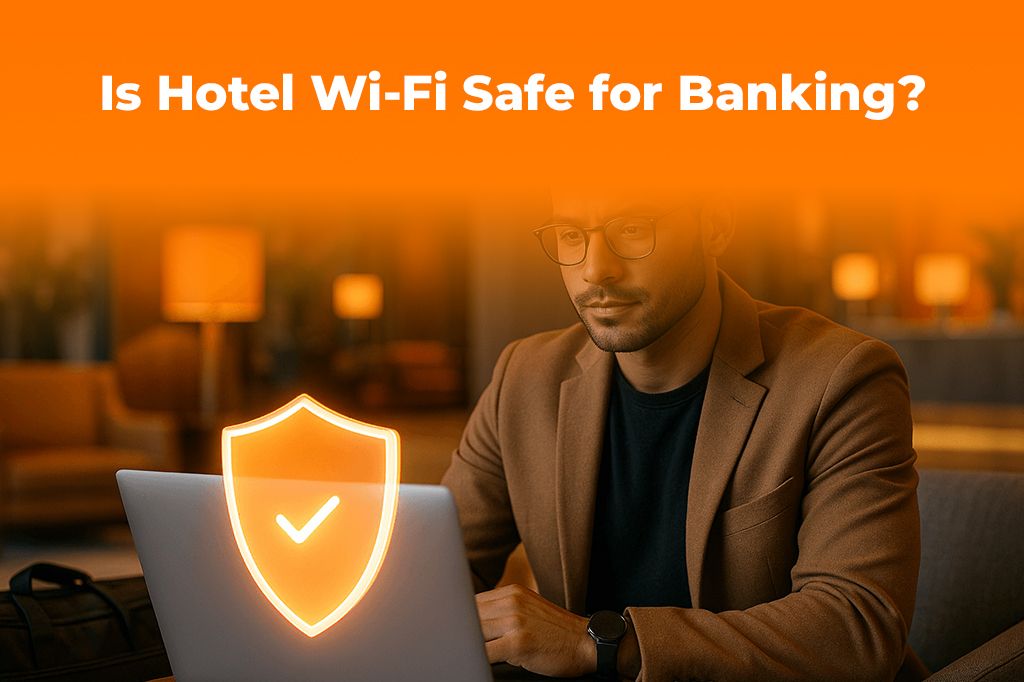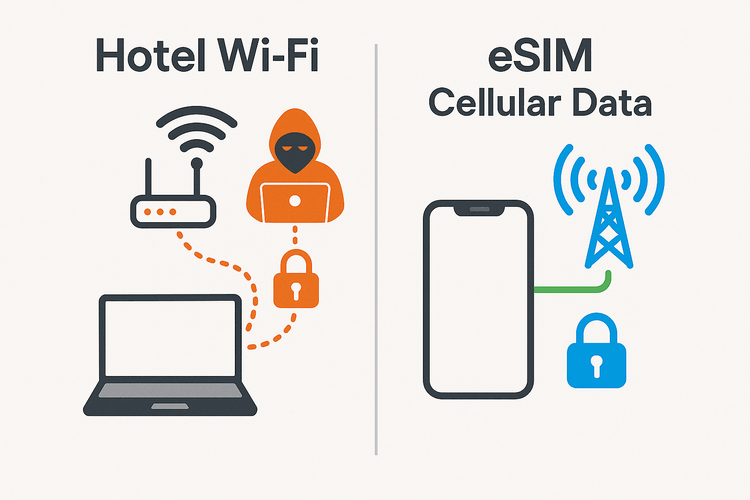You’ve just checked into your hotel after a long flight, and the first thing you do is connect to the free Wi-Fi. It’s time to check your bank balance, pay a bill, or transfer funds. But as you’re about to enter your password, a nagging question pops into your head: is hotel Wi-Fi safe for banking?
In 2026, with digital connectivity being more crucial than ever for travelers, this question is not just important—it’s essential for your financial security. The convenience of free Wi-Fi is tempting, but the risks are real and significant. This guide will explore the dangers of using banking apps on public networks and introduce a safer, more reliable alternative for modern travelers.
Before you log in, consider securing your connection from the start. With a Yoho Mobile eSIM, you can get online instantly with your own private, secure cellular data. Explore flexible data plans for your next destination.

The Hidden Dangers Lurking on Hotel Wi-Fi
Public Wi-Fi networks, including those in hotels, are notoriously insecure. They are often unencrypted and shared by hundreds of users, making them a prime target for cybercriminals. Here are some of the biggest threats you face when using your banking app on public Wi-Fi:
- Man-in-the-Middle (MITM) Attacks: This is one of the most common threats. A hacker positions themselves between your device and the Wi-Fi router, intercepting all the data you send and receive. This could include your banking credentials, credit card numbers, and personal information. According to cybersecurity experts at Norton, MITM attacks are a serious risk on public networks.
- Unencrypted Networks: Many hotel Wi-Fi networks lack strong encryption. This means the data transmitted between your device and the router is sent in plain text, like a postcard that anyone can read. A hacker on the same network can easily capture and read this data.
- Malware Distribution: Cybercriminals can use unsecured Wi-Fi to inject malware onto your device. If you accidentally connect to a malicious hotspot disguised as the hotel’s official network (an “Evil Twin” attack), you could unknowingly download software that steals your sensitive information.

Hotel Wi-Fi vs. Cellular Data: A Security Showdown
When it comes to travel digital security, not all connections are created equal. The difference between using hotel Wi-Fi and your own cellular data is like the difference between shouting your bank details across a crowded lobby and whispering them directly to the teller.
| Feature | Hotel Wi-Fi | eSIM Cellular Data |
|---|---|---|
| Network Type | Public, Shared | Private, Dedicated |
| Encryption | Often weak or non-existent | Strong, built-in (mandated by GSMA standards) |
| Security Risk | High (MITM, Snooping, Malware) | Very Low |
| Reliability | Variable, can be slow and congested | Generally stable and fast |
Your cellular connection is inherently more secure. It’s a direct, encrypted link between your device and the carrier’s network. This private channel makes it extremely difficult for criminals to intercept your data, providing the peace of mind you need when managing your finances abroad.
Why an eSIM is Your Best Bet for Secure Travel Banking
For the modern traveler in 2026, an eSIM (embedded SIM) is the ultimate tool for secure and convenient connectivity. It eliminates the need to rely on risky public Wi-Fi for important tasks. With a Yoho Mobile eSIM, you get a secure data connection the moment you land.
Here’s why an eSIM is the superior choice:
- Instant, Secure Connectivity: Activate your data plan before you even leave home. When you land in a new country, from the USA to Japan, you can connect to a secure local network immediately. No more hunting for a physical SIM card or connecting to unsecured airport Wi-Fi.
- Global Coverage, Local Rates: Yoho Mobile offers flexible plans for hundreds of destinations. Whether you’re traveling across Europe for a business trip or exploring Southeast Asia, you can build a plan that fits your needs without the high cost of traditional roaming.
- Peace of Mind with Yoho Care: What if you run out of data? The temptation to switch to unsecured Wi-Fi is strong. That’s where Yoho Care comes in. Even if your plan expires, we ensure you have a basic connection for essential tasks, so you’re never truly disconnected or forced to compromise your security.

Essential Cybersecurity Tips for Travelers in 2026
Using an eSIM is the best way to secure your connection, but you can enhance your travel digital security even further with these practices:
- Use a VPN: A Virtual Private Network (VPN) encrypts your internet connection, even on public Wi-Fi. It creates a secure tunnel for your data, making it a great second layer of defense.
- Enable Two-Factor Authentication (2FA): Always use 2FA for your banking and email accounts. This requires a second verification step (like a code sent to your phone), making it much harder for unauthorized users to gain access.
- Log Out After Use: When you’re finished with your banking session, always log out completely. Don’t just close the tab or app.
- Keep Software Updated: Ensure your phone’s operating system and your banking apps are always updated to the latest version to protect against known vulnerabilities.
- Check Your Device Compatibility: Before you travel, make sure your phone is unlocked and supports eSIM technology. You can check our comprehensive eSIM compatible devices list to be sure.
Frequently Asked Questions (FAQ)
Q1: What are the biggest risks of using a banking app on public networks?
The biggest risks are data theft through Man-in-the-Middle attacks, where hackers intercept your login credentials and financial information. Unencrypted networks also expose your activity, and malicious hotspots can install malware on your device, leading to potential financial loss and identity theft.
Q2: Is an eSIM more secure than public Wi-Fi for travel?
Absolutely. An eSIM provides a private, encrypted cellular connection directly to the carrier’s network. This is vastly more secure than a shared, often unencrypted public Wi-Fi network, making it the recommended choice for sensitive activities like online banking while traveling.
Q3: Can I make my hotel Wi-Fi connection safer?
Yes, you can improve its safety by using a reputable VPN, which encrypts your data. However, this doesn’t protect you from all risks, such as connecting to a fake “Evil Twin” network. Using a secure cellular connection via an eSIM remains the safest option.
Q4: Besides banking, what other activities are unsafe on hotel Wi-Fi?
You should avoid any activity that involves sensitive data. This includes logging into work accounts, online shopping with your credit card, accessing personal email, or filling out any form that requires personal information.
Conclusion: Don’t Gamble with Your Financial Security
The convenience of free hotel Wi-Fi simply isn’t worth the risk to your financial well-being. As we move through 2026, the threats to our digital security are more sophisticated than ever. The best way to access your bank account while traveling abroad is through a secure, private connection that you control.
A Yoho Mobile eSIM provides that control, delivering instant, secure, and affordable data wherever your travels take you. Protect your finances and enjoy true peace of mind on your next trip.
Ready to travel smarter and safer? Try Yoho Mobile’s free eSIM trial and experience the security of a personal data connection today.
